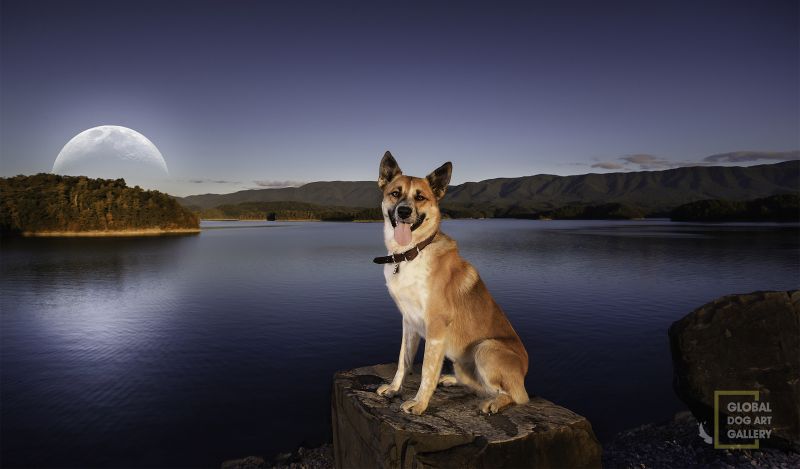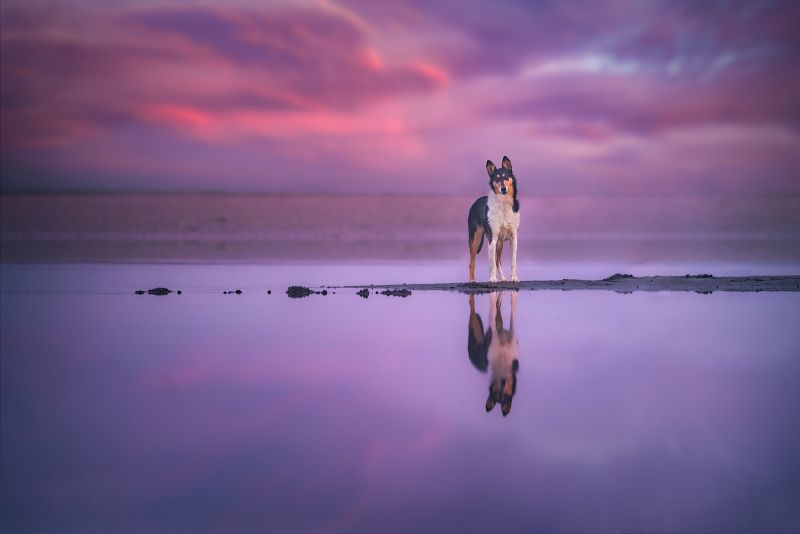
Among photography’s better known attributes is its capacity to inspire us in countless ways while capturing important (or even mundane) moments in time. For example, travel photographers make us want to visit places we’ve never heard of (as well as those we’re already familiar with), photojournalists add depth to their stories with imagery and motivate us to take action, and food photographers can turn an ordinary grilled cheese sandwich into a work of art. What you may not realize, however, is that photography can specifically serve as a means to help us make social connections and even work through emotional trauma (known as image therapy, or photo therapy). One genre of photography in particular that works especially well towards that end is pet photography.
Michael Puck, a philanthropist, HR professional, and dog photographer based out of Tennessee, recently launched the Global Dog Art Gallery to “uplift business environments with socially conscious and trust building dog wall art.” Pet photography has long been popular for personal portraits of family pets, but it now has the potential to create a significant social impact. The GDAG is an “online hub where companies can purchase dog wall art to support projects and initiatives that prevent suffering and save lives. This includes initiatives that eliminate puppy mills and dog fighting and initiatives that convert 100% of the over 3,000 animal shelters in the country to no-kill shelters.”
We interviewed Michael about his work with the Global Dog Art Gallery and gained some insight on the power of pet photography when used as image therapy and for social purposes. He also shared some incredible images from the gallery, captured by photographers from around the globe, that have to be seen to be believed.
See our interview with Michael Puck below.
1. What is Image Therapy (or Phototherapy) and why is it powerful?

In a clinical setting, phototherapy involves the structured use of photographs in counseling sessions to help patients open up to mental health professionals. Therapy is often difficult as patients almost always struggle to convey their experiences and emotions into words. However, patients can express how they relate to specific images and explain their significance in their lives. Pets are particularly important in improving the condition of many long-term mental health patients. Therefore, asking about their pets can lessen the patient’s anxiety as it directs their attention to the image rather than the counselor. Doing so gives them the confidence to engage in conversations, in which the counselor can reciprocate with their interest.
2. How does dog wall art instantly create trust?

Counselors can then observe the patient’s body language, facial expressions, and visual cues to understand them rather than relying on direct questions. Most importantly, it establishes trust between both parties.
3. How are pet photographs a part of the social catalyst effect?
Dog photography can also act as a social catalyst in a similar fashion to real-life pets. While studies have found that dogs attract people and act as an effective conversation starter, photographic images can also recreate the same effect. Having professional photographs of pets and dogs is a more accessible way to incorporate the presence of pets within hospitals, community centers, and business environments. According to the dog’s gaze experiment, viewers can get a dose of the hormone oxytocin simply by looking at their eyes from the photograph.

Beyond the application in clinical settings, research has confirmed in countless studies that images/photos can trigger emotions. In the case of dog photographs, the brain releases oxytocin, which is typically linked to warm, fuzzy feelings and shown in some research to lower stress and anxiety. Oxytocin has the power to regulate our emotional responses and pro-social behaviors, including trust, empathy, gazing, positive memories, processing of bonding cues, and positive communication. These are powerful, involuntary responses of the human body that relationship-oriented businesses can apply to their advantage.
Because of humans’ joint evolutionary development with dogs for the last 40,000 years, we have developed positive social responses to dogs and photographs of dogs. This all happens autonomically, but it makes it easy to understand why research proves that interactions with strangers increase 21-fold when dogs are present. This effect is one of the reasons why there have been over 230 dogs in the Oval Office throughout 46 Presidents. Dogs and, by extension, dog photographs humanize us and help people connect.
4. What inspired you to create this platform?

My inspiration for launching the Global Dog Art Gallery is to feature the best photographers worldwide and promote their work to businesses that can benefit from the social catalyst effect of dog wall art in order to help save 1 million dogs by 2030. I started my photography business, K9Photo, in 2016 as a nonprofit in honor of my childhood dog, Cora, who saved my life.
At the age of four, I suffered a severe burn that landed me in solitary isolation for three weeks. Not even my parents were allowed to see me. The event profoundly affected me, causing me to become a loner and not trust anyone. At the time, people were just concerned with my physical scar; my mental scars weren’t on the radar. I became increasingly depressed until my family adopted a black lab.
I instantly bonded with her. We spent hours walking through the woods, along the rivers, and built a relationship that was unmatched by any relationship I had with human beings at that point. She was the one who re-introduced me to my environment. She was so social and cute, and everyone came running when they saw us out and about. I don’t know where I would be if I had stayed on the trajectory I was on — she saved my life.
5. What is the biggest challenge in creating and curating these photos?

I am beginning to add the work of my favorite dog photographers to the Global Dog Art Gallery. I have uploaded some of my work, but I plan to have less and less of my photos in the online gallery over time. I have sold wall art collections to several businesses and continue to develop my own photography, but the real mission is to create a platform that helps others showcase their craft while contributing to the larger cause of saving animals.

The biggest challenge is deciding which photographs to include in the Global Dog Art Gallery because there are so many truly talented and gifted dog photographers. My goal for the GDAG is to create a highly curated selection of dog wall art that cannot be found anywhere else. This will include diverse styles and approaches to dog photography that will reach various environments, company cultures, employee demographics, and customer or client Demographics.
6. What cameras, lenses, and lighting gear were used to create the photos?

The majority of my photographs are created with a Canon 1DX, Canon 70-200mm f/2.8, Canon 17-40mm f/4, and a Sigma Art 35mm f/1.4. I use OCF for about half of my photographs. My go-to lighting equipment is two Westcott FJ 400 strobes.
7. Do you have a favorite photo from the series/gallery? If so, which one, and why?

Yes, I do have a few favorites. Many of them are lucky byproducts of trying something new when taking my own dogs as models. Here is one example of playing with my Foxhound on a field filled with wildflowers.
8. For photographers looking to create impactful images like this, could you share your process of coming up with your concepts and ideas?

My childhood experience with a dog allowed me to connect with them deeply, and I would suggest that photographers choose subjects they are passionate about. For photographers considering dog photography, I would recommend starting by learning about dogs and their behavior. This can differ substantially by breed, age, and a number of other factors. If the photographer cannot put the dog at ease or connect with the dog, the photographs will not show the dog’s true personality. Once the connection is established, then you can capture the dog’s soul on “film.”
9. What are you currently working on? What’s next?

Launching the Global Dog Art Gallery is a boatload of work in itself, but I am also developing training content to help dog photographers learn how to sell their work to non-pet-related businesses. I was fortunate that my background as a people-scientist and business consultant provided me with deep insight into today’s businesses’ needs and pain points. I connected these insights with my personal experience and in-depth research about the human-canine relationship. I stumbled upon this by chance, when one of my customers decided to hang my pictures of her dog in her workplace. I received messages from her for weeks on end, where she shared all the positive feedback and new conversations that the photos had sparked.
[Related Reading: Pet Photography Guide | Gear, Tips, and Common Mistakes to Avoid]
Additional Images







About Michael Puck
Michael Puck is a philanthropist, HR professional, and dog photographer who recognized the benefit of the human-canine connection to make a difference in the lives of animals and humans alike. He is currently operating as a senior partner in the UKG Human Insights Group and is a Senior Certified Professional with the Society of Human Resource Management (SHRM-SCP), a published author, and a frequent presenter. He combines his love for animals and photography as the President of the nonprofit K9Photo and Founder of the Global Dog Art Gallery.




Get Connected!